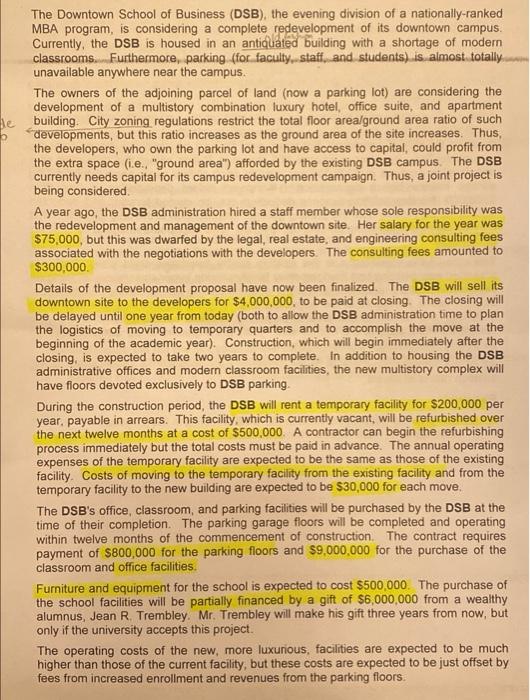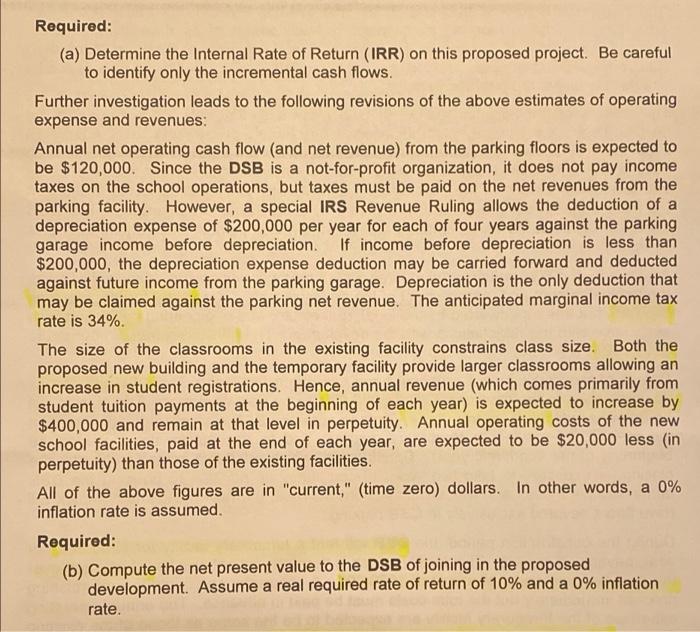b The Downtown School of Business (DSB), the evening division of a nationally-ranked MBA program, is considering a complete redevelopment of its downtown campus. Currently, the DSB is housed in an antiquated building with a shortage of modern classrooms. Furthermore, parking (for faculty, staff, and students) is almost totally unavailable anywhere near the campus. The owners of the adjoining parcel of land (now a parking lot) are considering the development of a multistory combination luxury hotel, office suite, and apartment le building City zoning regulations restrict the total floor arealground area ratio of such developments, but this ratio increases as the ground area of the site increases. Thus, the developers, who own the parking lot and have access to capital, could profit from the extra space (i.e., "ground area") afforded by the existing DSB campus. The DSB currently needs capital for its campus redevelopment campaign. Thus, a joint project is being considered A year ago, the DSB administration hired a staff member whose sole responsibility was the redevelopment and management of the downtown site. Her salary for the year was $75,000, but this was dwarfed by the legal, real estate, and engineering consulting fees associated with the negotiations with the developers. The consulting fees amounted to $300,000 Details of the development proposal have now been finalized. The DSB will sell its downtown site to the developers for $4,000,000, to be paid at closing. The closing will be delayed until one year from today (both to allow the DSB administration time to plan the logistics of moving to temporary quarters and to accomplish the move at the beginning of the academic year) Construction, which will begin immediately after the closing, is expected to take two years to complete. In addition to housing the DSB administrative offices and modern classroom facilities, the new multistory complex will have floors devoted exclusively to DSB parking During the construction period, the DSB will rent a temporary facility for $200,000 per year, payable in arrears. This facility, which is currently vacant, will be refurbished over the next twelve months at a cost of $500,000. A contractor can begin the refurbishing process immediately but the total costs must be paid in advance. The annual operating expenses of the temporary facility are expected to be the same as those of the existing facility. Costs of moving to the temporary facility from the existing facility and from the temporary facility to the new building are expected to be $30,000 for each move. The DSB's office, classroom, and parking facilities will be purchased by the DSB at the time of their completion. The parking garage floors will be completed and operating within twelve months of the commencement of construction. The contract requires payment of $800,000 for the parking floors and $9,000,000 for the purchase of the classroom and office facilities Furniture and equipment for the school is expected to cost $500,000. The purchase of the school facilities will be partially financed by a gift of $6,000,000 from a wealthy alumnus, Jean R Trembley. Mr. Trembley will make his gift three years from now, but only if the university accepts this project. The operating costs of the new, more luxurious, facilities are expected to be much higher than those of the current facility, but these costs are expected to be just offset by fees from increased enrollment and revenues from the parking floors. Required: (a) Determine the Internal Rate of Return (IRR) on this proposed project. Be careful to identify only the incremental cash flows. Further investigation leads to the following revisions of the above estimates of operating expense and revenues: Annual net operating cash flow (and net revenue) from the parking floors is expected to be $120,000. Since the DSB is a not-for-profit organization, it does not pay income taxes on the school operations, but taxes must be paid on the net revenues from the parking facility. However, a special IRS Revenue Ruling allows the deduction of a depreciation expense of $200,000 per year for each of four years against the parking garage income before depreciation. If income before depreciation is less than $200,000, the depreciation expense deduction may be carried forward and deducted against future income from the parking garage. Depreciation is the only deduction that may be claimed against the parking net revenue. The anticipated marginal income tax rate is 34% The size of the classrooms in the existing facility constrains class size. Both the proposed new building and the temporary facility provide larger classrooms allowing an increase in student registrations. Hence, annual revenue (which comes primarily from student tuition payments at the beginning of each year) is expected to increase by $400,000 and remain at that level in perpetuity. Annual operating costs of the new school facilities, paid at the end of each year, are expected to be $20,000 less (in perpetuity) than those of the existing facilities. All of the above figures are in "current" (time zero) dollars. In other words, a 0% inflation rate is assumed. Required: (b) Compute the net present value to the DSB of joining in the proposed development. Assume a real required rate of return of 10% and a 0% inflation rate








